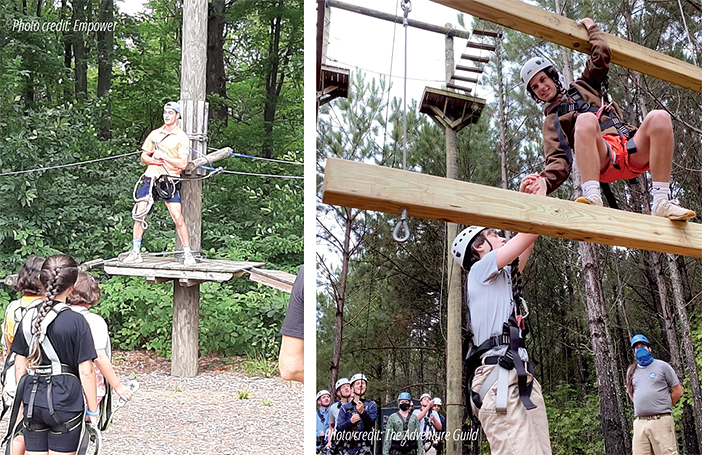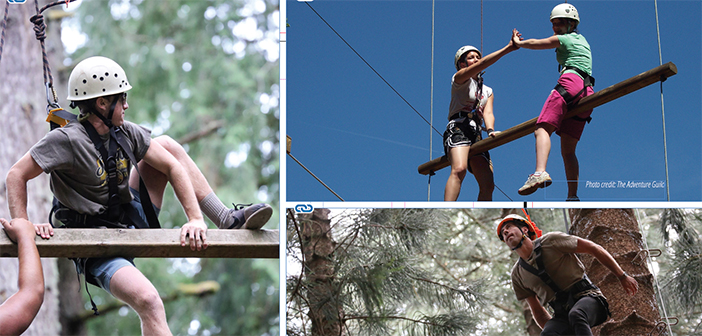In our industry, the term “facilitation” is most often associated with the traditional experiential field, where “facilitators” use their skills—which can take years of training and practice to develop—to help clients achieve desired outcomes. Facilitators know what questions to ask and how to read emotions, help clients overcome fear, and help them have fun in the process. It’s a valuable skill set for those who work with people at height.
But can a degree of facilitation be incorporated at commercial adventure parks and zip line tours?
“An emphatic yes to that question,” says Lisa Hunt, senior trainer and team development program manager at High 5 Adventure. While the role of a facilitator—or guide—may change in scope depending on the type of course, she says, “if you think about the role of a facilitator as an expert host who can help shape people’s experience, it’s not a reach to see that it’s important everywhere.”
To be clear, zip line guides and adventure park monitors do not need to be facilitators in the traditional sense. That level of facilitation would often be untenable in a high-throughput environment. There are certain facilitation skills and tools that can be taught in relatively little time, though, and when put into practice, can have a meaningful, positive impact on people and business.
Consider, too, that the definition of facilitate is “to make easy or easier.” Doesn’t that sound like a good thing for staff to know how to do?
Universally Applicable
We all experience situations in which facilitation enhances the experience, even if we don’t recognize it as such.
“If you’re out to dinner and you have a really good server, that person is facilitating your experience,” says Synergo CEO Erik Marter. “A typical server nowadays just asks what you want, takes your order, and brings you your food. They’ve lost the art of service. It’s turned into ‘serve us.’ Whereas in a nice restaurant, you sit down and the server is engaging and actively listening—you can talk about wine if you want to, or talk about the food, you can actually learn some stuff and connect with this human being and have a nice interaction.”

Facilitation requires connection and communication to produce desired outcomes.
In the context of an adventure park, the typical server would be a monitor who hasn’t been trained in facilitation. The monitor might see someone struggling on an element, and suggest a solution—but fail to help the person find the courage and confidence to attempt the solution. Or, the monitor might convey impatience with the guest while making a suggestion. As a result, a frightened guest gets frustrated and feels incompetent, and perhaps more frightened. >>
Facilitation skills vs. soft skills. For someone to effectively facilitate any kind of experience, he or she needs to be adept at communicating and problem solving, which are considered soft skills. Are facilitation skills different than soft skills, then?
View them as an extension of soft skills, says Hunt. “I see soft skills as a set of skills that I carry with me in most/all situations that allow me to most effectively connect with people. Facilitation skills expand on that to include my ability to plan and execute an experience that is designed to meet the needs of a person or group.”
Empower Leadership president Dan Jaskot says facilitation is about being more intentional with your standard soft skills. “As in, asking a question and not having the answer go in one ear and out the other,” he says. “It’s about gathering some data about who [participants]are so you can meet them where they’re at, and then also it’s a huge trust-building element.”
Another view: consider soft skills a prerequisite to learning facilitation skills. (Read about the benefits of soft skills training in “Soft Skills, Solid Impact” on p. 12.)
A Great Opportunity
One of the main differences between guided, self-guided, and facilitated experiences—or, for example, a zip line tour, aerial adventure park, and traditional high ropes course—is the guests’ expectations for what they’re going to get out of it, says Synergo COO Kyle Bruser. “If you sign up for a day on a challenge course, your expectation is you’re going to get certain outcomes out of it,” he says.
Whereas going on a zip line tour or climbing at an adventure park comes with different expectations. “Guests expect to fly through the treetops, they expect to climb,” says Jaskot. “But facilitation allows guides and monitors to take a stock canopy tour and personalize it for the individual, or the family, or the group that’s participating.”
By asking some questions and starting conversations among the people on a tour, guides can turn it into a more impactful experience. “We have a really good ability with people when they’re in that scared state to encourage them and get them talking and get them thinking about stuff,” says Marter. “When they’re in that state together, they naturally bond together and you can ask them some questions and they go away knowing more about their own selves and other human beings. It’s not that hard to do, so why not do it?”
Read the room. However, successfully facilitating the kind of experience guests don’t expect, but welcome, requires “reading the room.”
“The ability to read the room is what allows an operation to take an experience that from the outside standpoint and physical standpoint may seem like it’s going to be the same for everybody—but from the social and emotional standpoint, it can be an extremely different experience for each individual,” says Jaskot. “Outside of safe operation and technical aspects, being able to read the room is the next most important thing in any adventure operation.”
How does one read the room? “We tell our guides and monitors to ‘meet the customer where they’re at,’” he says. “To do that, you have to have a level of comfort in having conversations with people—not necessarily prying, but asking questions like, ‘Is this your first time zip lining or climbing? Are you celebrating anything special today?’ Simple, conversational questions that to the guest it may seem like just striking up conversation, but to us it’s gathering information about who this person or who this group is and what they’re hoping to get from this experience with us.”
Part of this data collection, too, is to learn up front what guests don’t want. Marter says it’s best to be open with them. “You can say, ‘During the tour I might ask you some questions so you can get to know each other a little better, get to know yourselves a little better. If you don’t want that, just let me know. If you want more of that, let me know,’” he says.
Learning the Ropes
Staff training takes time and costs money. Of course, technical skills and safety training are paramount, and demand the most time. Adding some facilitation skills training to your program doesn’t require a lot of time or money, though—and the return can be substantial.

Make facilitation part of your guide training program to give trainees an experience with the approach. Their skills can be applied during any guest interactions—an hours-long zip tour, ground school, on course, etc.
Marter and Bruser agree that during, say, a three- or four-day training, discussion about facilitation skills may add anywhere from one to three hours of time, depending on the operation. “In terms of ROI,” says Bruser, “it’s an hour of doing an extra bit of training with people, but in terms of the product, you’re creating a memory versus just something someone did.”
Modeling behavior. Don Stock, president of The Adventure Guild, suggests incorporating team development components—games, activities, mixers—into your training so staff can experience a facilitated group dynamic.
The next step is to bring the guides out on course. “When we’re out as a group, we play some of these games,” says Stock. “We don’t tell them that we’re actually doing it intentionally, but we’re actually teaching them what to do, and they’re active participants in it. ‘Now, see what we just did? Here’s how you can apply that.’”
Marter also suggests on-course training, or modeling, for new guides as a way to learn facilitation skills. One approach is to take them through the tour a couple of times. The first time without talking much, “and the next time ask them questions and engage with them a little bit differently. Afterwards, ask, ‘Did you notice a difference? And what did you like about that?’” he says. Modeling ways to ask questions and ways to connect with people gets the guides thinking about the approach.
Mentoring. After the on-course staff at Empower’s three locations complete their training and certifications, they partner with an experienced guide to help ease them into the job, Jaskot says.
“Sometimes the new guides are so uber focused on the technical and safety elements while out on a course, they’ll become mute,” he explains. “That’s a good thing, really, because we want them to dedicate a vast majority of their focus to making sure the technical skills are executed properly so it’s a safe experience. But that comes at the expense of the social and facilitation side of the job.”
This buddy system allows new guides to focus on safety but benefit from observing the interactions that experienced guides have with guests. “A lot of the training in social and facilitation skills comes during the time when they’re buddied up, and the learning happens during the guide-to-guide debrief afterwards,” says Jaskot. “The experienced guide recalls a situation on the course, discusses it, and that begins to build up the new guide’s repertoire.”
He says to be intentional with these discussions so the new guide can fully understand why the experienced guide said or did certain things.
OTHER CONSIDERATIONS
Hire for attitude, train for skills. “It’s easier to teach somebody who’s a really good people person knots and ropes than it is to teach somebody who’s really good with ropes and knots how to be a good people person,” says Marter.
Culture is key. “You can teach people what to say in a situation, but it doesn’t work without the culture,” says Stock. “You’ve got to have leadership who care about people, who care about their experience, who care about the fact that people are coming for this experience and they may have a moment during it, and care more about helping them through that moment than being solely focused on the numbers and cycling people through as quickly as possible. That’s the enemy of this. If you have leadership that’s all about the numbers, this won’t work.”
It doesn’t need to be complicated. At self-guided adventure parks, “Developing some sort of connection with customers through small talk or asking simple questions—during check in, or ground school, or just when customers walk by you—is important because the customer is more likely to listen to you and trust you out on the course. You’re not just some stranger in a staff uniform,” says Jaskot.
Desired outcomes. “As we tell guides when we’re training them, if you are finishing up the tour and everyone looks at you and says, ‘Thank you, you’re a great human being,’ and they go write a nice review, you did a good job,” says Marter. “If you walk away and group members are exchanging phone numbers and connecting with each other and going to get a beer with each other, you did a great job.”
Facilitation is different from teaching. That desired outcome illustrates the difference between facilitating and teaching or lecturing—facilitating is more interactive and personal. “I am stepping into a role of facilitation when I am connecting with participants, and they are also connecting with each other,” says Hunt.
Bottom line? The consensus among operators and experts is zip line tours and adventure parks with staff that incorporate some level of facilitation into the experience get better reviews, and staff earn bigger tips. That makes facilitation a win for everyone.






